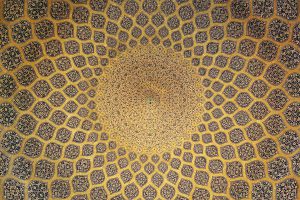Musings on Tafsīr al-Jalālayn
By Sulaiman Hamid (5th Year Alim Student, DarusSalam Seminary)
The Qurʾān, being the Speech of Allāh and a miracle to mankind, contains many profound secrets. To understand and explain these deeper meanings, Allāh inspired the scholars to write tafsīr expounding on it. That is why, today, we find hundreds of such works written by scholars from all over the world. They range from being short and concise to being encyclopedic works printed in volumes. One tafsīr that has gained acceptance throughout the world is Tafsīr al-Jalālayn.
Tafsīr al-Jalālayn is studied throughout the Muslim World by students embarking on their journey to learn the tafsīr of the Qurʾān. This work was compiled by two amazing scholars: Jalāl al-Dīn al-Maḥallī and Jalāl al-Dīn al-Suyūṭī. And because they are both named Jalāl al-Dīn, its title is the dual form of their respective names: “al-Jalālayn.”
Maḥallī started this tafsīr. His full name is Jalāl al-Dīn Muḥammad b. Aḥmad b. Muḥammad b. Ibrāhīm al-Maḥallī. He was born in AH 791 and grew up studying Islām. He was a bright student who excelled in many subjects, including jurisprudence (ar. fiqh), theology (ar. kalām), legal theory (ar. uṣūl), grammar (ar. naḥw), and logic (ar. manṭiq).
He had sharp mind. However, he would say that his ability to understand was superior to his memory. He was very pious, lived an ascetic lifestyle, and stood up for the truth. He was offered the position of chief justice (ar. qāḍī) but refused it. Rather than serving the magistrate, he went on to teach. Throughout his life, he wrote numerous books, many of them are widely accepted and studied even today.[1]
This amazing personality passed away in AH 864. And he did not complete his tafsīr.
Another brilliant scholar came and completed it. Jalāl al-Dīn Abū al-Faḍl ʿAbd al-Raḥmān b. Abī Bakr b. Muḥammad al-Suyūṭī completed the tafsīr that his teacher started. Suyūṭī was born in AH 894. His father passed when he was five years old. Having a phenomenal memory, he memorized the Qurʾān at the age of eight. Thereafter, he memorized several compilations of ḥadīth under the tutelage of his teachers.
He was very knowledgeable in the Islāmic Sciences, especially in the field of ḥadīth. Suyūṭī was a prolific author who compiled around 600 books and treatises.[2] In fact, one of his students is reported to have observed him write three treatises in a single day.
As for his knowledge of ḥadīth, he said that he had memorized 100,000; and if he found more, he would have memorized those too. At the young age of forty, he turned away from this world and secluded himself to worship. He left teaching and giving legal edicts (ar. iftāʾ), for which he apologized in his book al-Tanfīs fī al-Iʿtidhār ʿan Tark al-Iftāʾ wa al-Tadrīs.
The work, Tafsīr al-Jalālayn, was compiled by these two exceptionally knowledgeable scholars. Maḥallī, who was Suyūṭī’s teacher, was the first author of the book. He started the tafsīr, writing from Sūrat al-Kahf to Sūrah al-Nās. And thereafter, he started with Sūrat al-Fāṭiḥah. Then, he passed away. Suyūṭī assumed the task of completing the it. In forty days, he wrote from Sūrat al-Baqarah to Sūrat al-Isrāʾ.
The author of Kashf al-Ẓunūn is of the opinion that Maḥallī wrote the first half, up to Sūrat al-Isrāʾ, before he passed away. Then, Suyūṭī completed it along with the tafsīr of Sūrat al-Fāṭiḥah. However, at the end of Sūrat al-Isrāʾ, it is written: “This is the last of the tafsīr of the Qurʾān that I completed, that which was authored by Maḥallī.”[3] Other scholars also opine that Maḥallī wrote the second half.
Moving on to the style of writing in both sections, one may barely notice any difference. Suyūṭī adopted Maḥallī’s concise style while completing the work. In fact, Suyūṭī sometimes relies on Maḥallī’s existing tafsīr, as stated at the end of the commentary on Sūrat al-Isrāʾ. He relies on it for declensions (ar. iʿrāb), scholarly differences of opinion (ar. ikhtilāf), the modes of recitation (ar. qirāʾāt), and explanations of allegorical verses (ar. mutashābih ayāt).
Even though both portions are similar, one may notice some differences. These are found in a few places in the tafsīr. One such place is the tafsīr of the word “rūḥ.” Maḥallī, in Sūrah Ṣād, explains it as an inanimate body (ar. jism laṭīf), which when placed in a person gives him life. Suyūṭī agrees with him in Sūrat al-Ḥijr, but in Sūrat al-Isrāʾ he says that only Allāh knows its reality and that refraining from explaining it is better.
When explaining the word Ṣāʾibūn, Maḥallī stated that they are Jews.[4] Then, later on, Suyūṭī says that they are Jews or Christians.[5] These differences are so minor that they may go unnoticed while studying the tafsīr. Hence, one may conclude that both parts of the tafsīr are similar in style.
A seeker of knowledge must study this amazing work. Even one who understands Arabic, should strive to read it so he may understand the message of the Qurʾān. One distinct quality of this tafsīr is its conciseness. The author of Kashf al-Ẓunūn mentioned that he counted the letters in both the tafsīr and the Qurʾān and found them to be equal until Sūrat al-Muzammil. And thereafter, there was more tafsīr than Qurʾān. For this reason, some concluded that it is permissible, although not recommended, to touch this tafsīr without ablution.
Tafsīr al-Jalālayn has been accepted by Allāh. It is taught in various institutes of higher learning around the world. There are many commentaries and marginalia that have been penned expounding on this work.[6]
This work should be studied by every student. By reading it one will observe how knowledge can be understood and conveyed not only by the copious amounts of writing, but also through abundant meaning conveyed in a few words. This work shows us how such an abundance of knowledge can be conveyed in this manner.
[1] Aʿlām, 5:333.
[2] Aʿlām, 3:301.
[3] This indicates to that the portion written by Maḥallī was after Sūrat al-Isrāʾ. For more details regarding this see: al-Tafsīr wa al-Mufassirūn, 1:333.
[4] See: the tafsīr on Sūrat al-Ḥajj.
[5] See: the tafsīr on Sūrat al-Baqarah.
[6] Some of them are: Majmaʿ al-Baḥrayn wa Maṭlaʿ al-Badarayn, al-Jamālayn, Qabas al-Nayyirayn, Ḥāshiyah al-Ṣāwī, and Ḥāshiyat al-Jamal.


